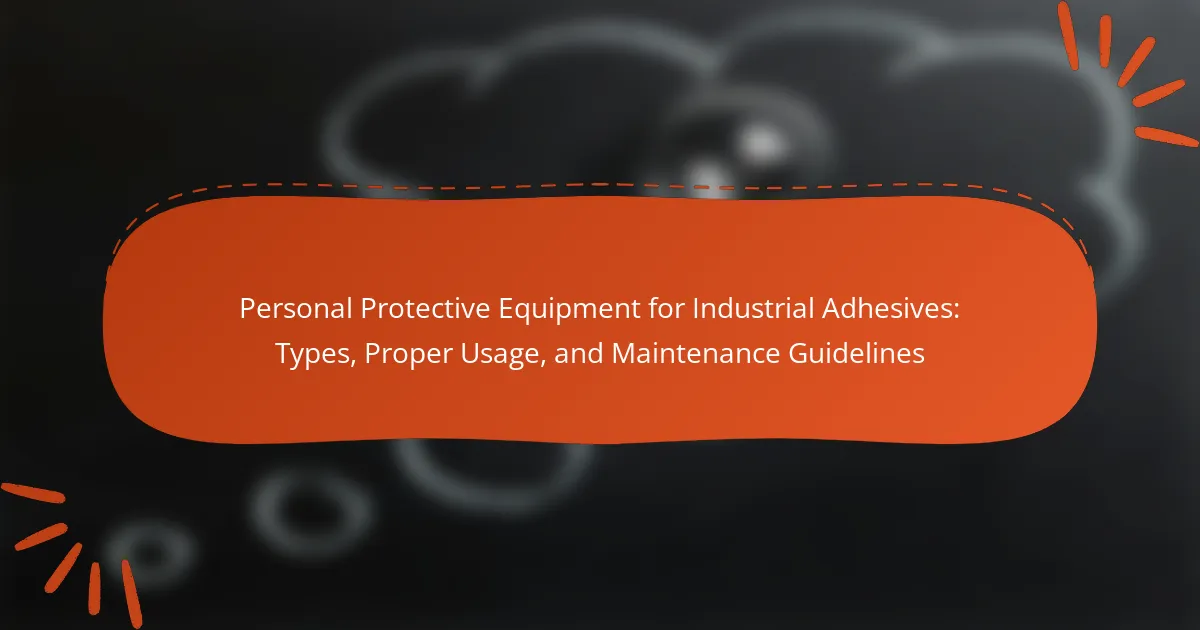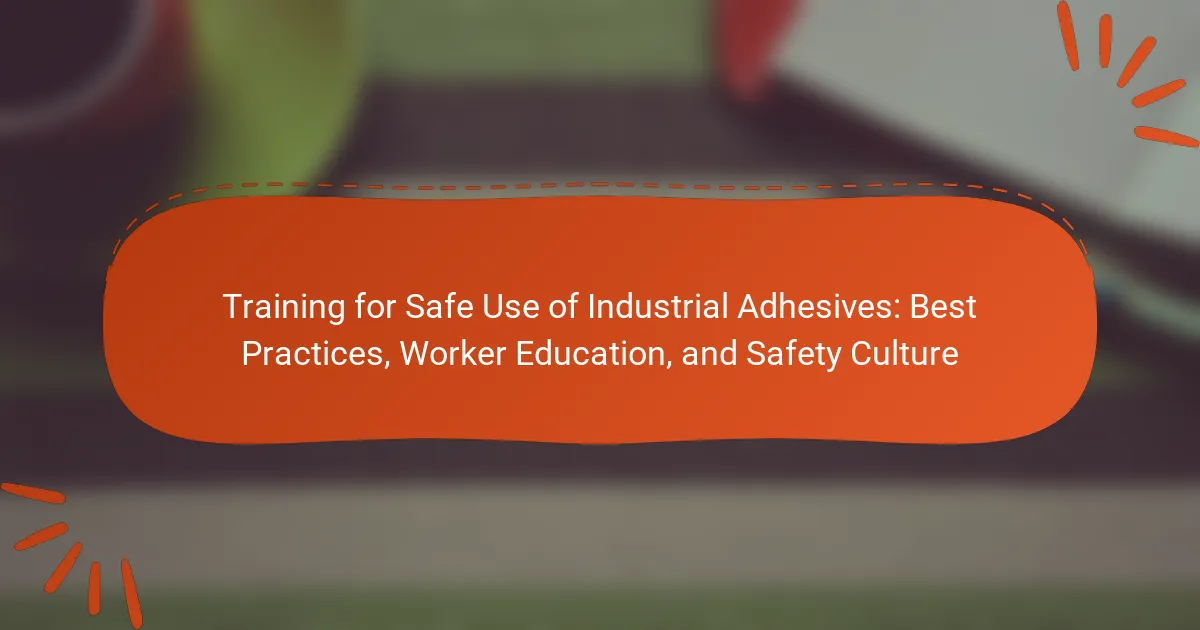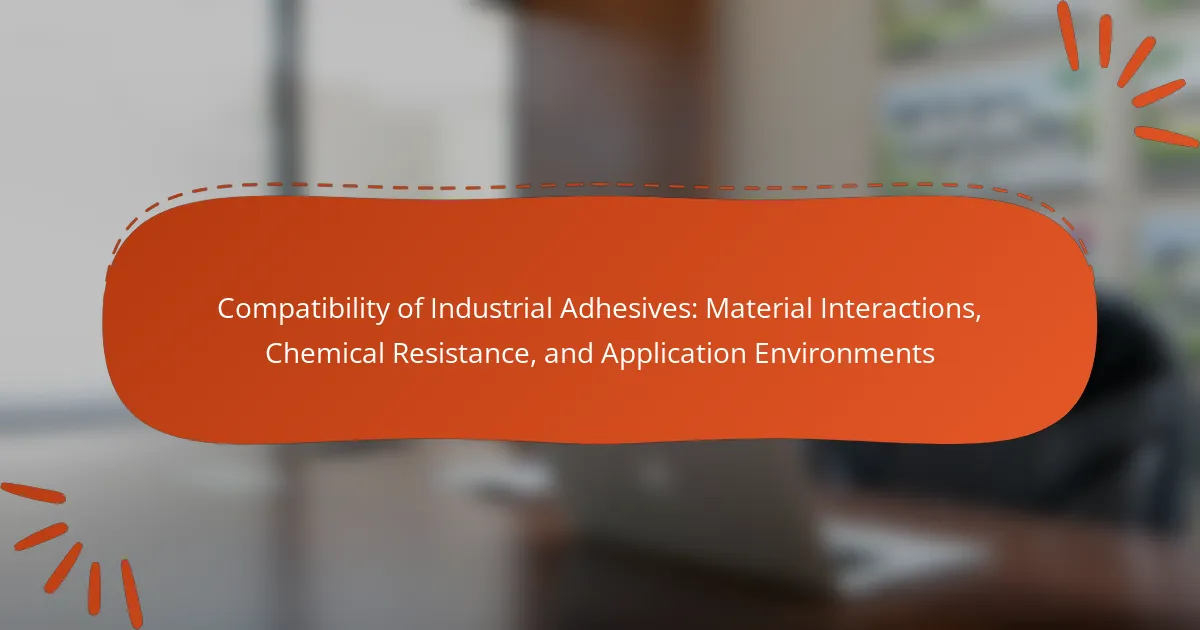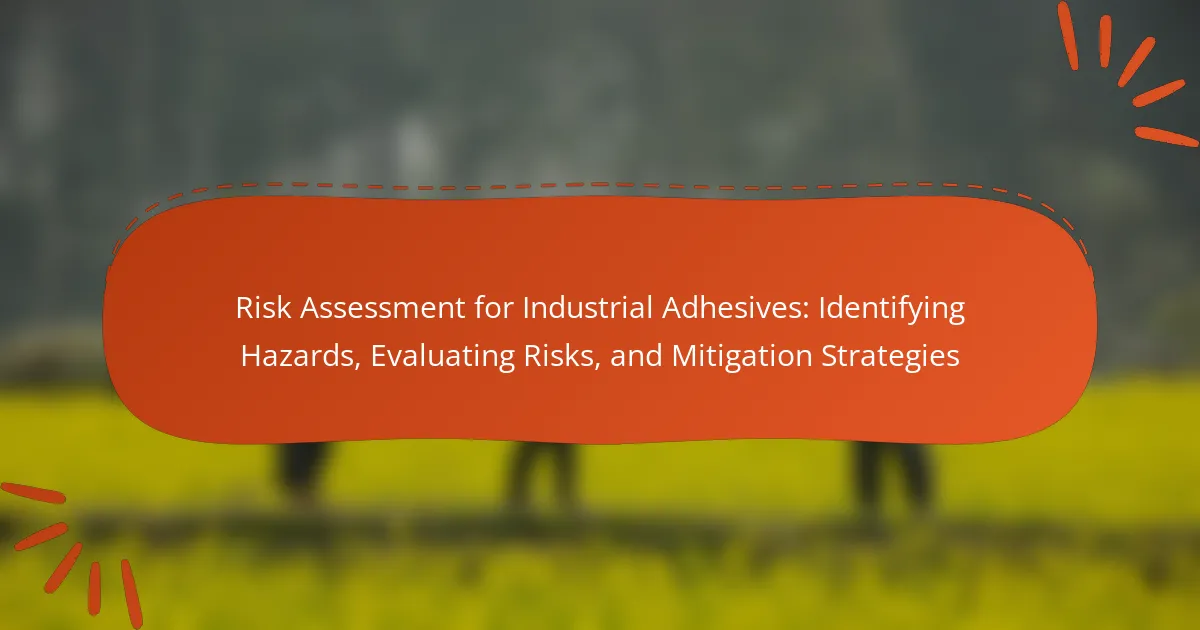Personal Protective Equipment (PPE) for industrial adhesives is essential for safeguarding workers from hazardous substances. This article covers the types of PPE, including gloves, goggles, and respirators, and emphasizes their importance in preventing skin contact, eye exposure, and inhalation of harmful vapors. Proper selection, fit, and usage practices are crucial for maximizing safety, alongside regular inspections and maintenance to ensure effectiveness. Compliance with OSHA guidelines is highlighted as a key factor in reducing workplace injuries and illnesses related to industrial adhesives. The article provides detailed maintenance guidelines to ensure PPE remains in optimal condition.
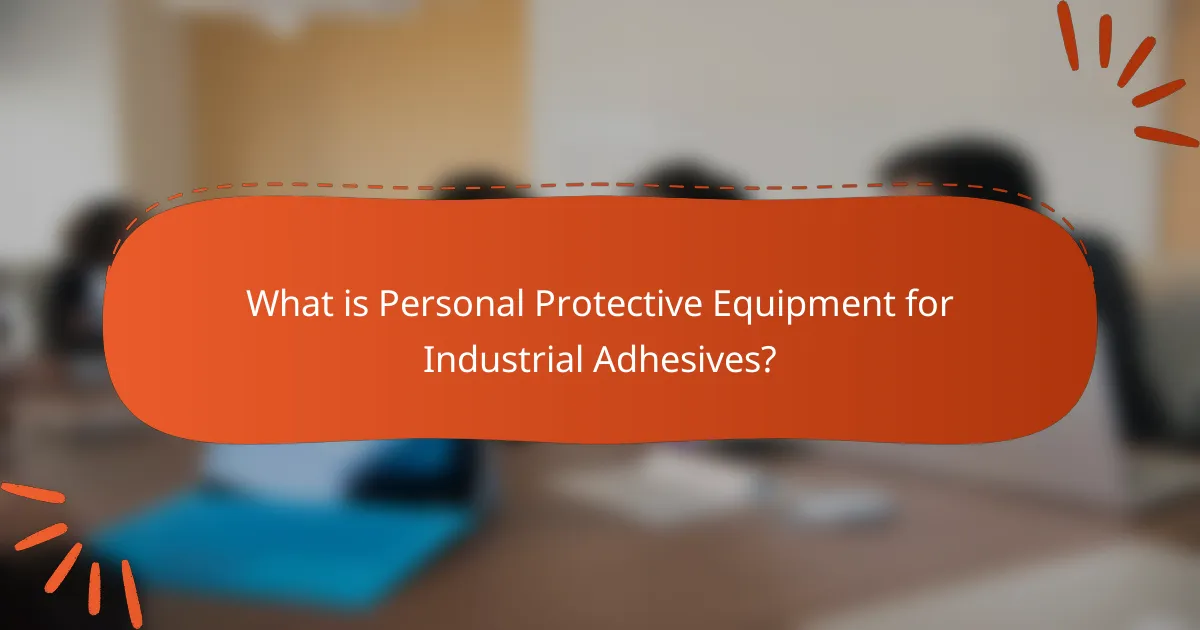
What is Personal Protective Equipment for Industrial Adhesives?
Personal Protective Equipment (PPE) for industrial adhesives includes gear designed to protect workers from exposure to hazardous substances. This equipment typically consists of gloves, goggles, and respirators. Gloves prevent skin contact with adhesives, which can cause irritation or allergic reactions. Goggles safeguard the eyes from splashes and fumes. Respirators protect against inhalation of harmful vapors. The use of PPE is essential in maintaining safety standards in environments where industrial adhesives are used. According to OSHA guidelines, proper PPE usage significantly reduces the risk of injury and illness in the workplace.
Why is Personal Protective Equipment essential when working with industrial adhesives?
Personal Protective Equipment (PPE) is essential when working with industrial adhesives to protect workers from hazardous chemicals. Industrial adhesives often contain toxic substances that can cause skin irritation, respiratory issues, or eye damage. PPE such as gloves, goggles, and respirators acts as a barrier against these harmful effects. Studies show that exposure to certain adhesives can lead to long-term health problems, reinforcing the need for proper protection. Additionally, the Occupational Safety and Health Administration (OSHA) mandates the use of PPE to ensure workplace safety. By using PPE, workers significantly reduce their risk of injury and exposure to harmful chemicals.
What are the potential hazards associated with industrial adhesives?
Industrial adhesives can pose several potential hazards. These hazards include chemical exposure, flammability, and health risks. Chemical exposure can occur through inhalation, skin contact, or ingestion. Many industrial adhesives contain volatile organic compounds (VOCs) that can lead to respiratory issues. Flammability is a concern, especially with adhesives that contain solvents. These materials can ignite and cause fires if not handled properly. Health risks may include skin irritation, allergic reactions, or long-term health effects from chronic exposure. Proper safety measures, such as using personal protective equipment (PPE), can mitigate these risks.
How does Personal Protective Equipment mitigate these hazards?
Personal Protective Equipment (PPE) mitigates hazards by providing a physical barrier against exposure. PPE includes items such as gloves, masks, goggles, and protective clothing. These items are designed to protect workers from harmful substances, chemicals, and physical injuries. For example, gloves prevent skin contact with industrial adhesives, reducing the risk of chemical burns. Masks filter out harmful vapors and airborne particles, safeguarding respiratory health. Goggles protect the eyes from splashes and irritants, preventing damage. Proper usage of PPE is crucial for effectiveness. Regular maintenance ensures that PPE remains functional and reliable. Studies show that consistent use of PPE decreases injury rates in industrial settings.
What types of Personal Protective Equipment are available for industrial adhesive use?
Personal Protective Equipment (PPE) for industrial adhesive use includes gloves, goggles, respirators, and protective clothing. Gloves protect hands from chemical exposure. Goggles shield eyes from splashes and fumes. Respirators filter harmful airborne particles and vapors. Protective clothing prevents skin contact with adhesives. Each type of PPE is essential for safety in environments where adhesives are used. Proper selection and usage of PPE reduce the risk of injury and health issues.
What are the key categories of Personal Protective Equipment for this purpose?
The key categories of Personal Protective Equipment (PPE) for industrial adhesives include gloves, eye protection, respiratory protection, and protective clothing. Gloves protect the hands from chemical exposure and abrasion. Eye protection, such as goggles or face shields, safeguards against splashes and harmful vapors. Respiratory protection, including masks or respirators, prevents inhalation of harmful fumes. Protective clothing, such as coveralls or aprons, shields the skin from adhesive contact. These categories are essential to ensure safety while handling industrial adhesives.
How do different types of Personal Protective Equipment compare in terms of protection level?
Different types of Personal Protective Equipment (PPE) vary significantly in their protection levels. Respirators offer high protection against airborne contaminants, filtering out harmful particles. Gloves provide a barrier against chemical exposure, with specific materials designed for different substances. Safety goggles protect the eyes from splashes and flying debris, ensuring visibility and safety. Face shields provide additional [censured] protection but should be used with goggles for optimal safety. Hard hats protect against head injuries from falling objects, while steel-toed boots safeguard the feet from heavy impacts. Each type of PPE is rated based on its specific protective capabilities, ensuring users select the appropriate gear for their tasks. For example, NIOSH rates respirators based on their filtration efficiency, establishing standards for safe use in hazardous environments.
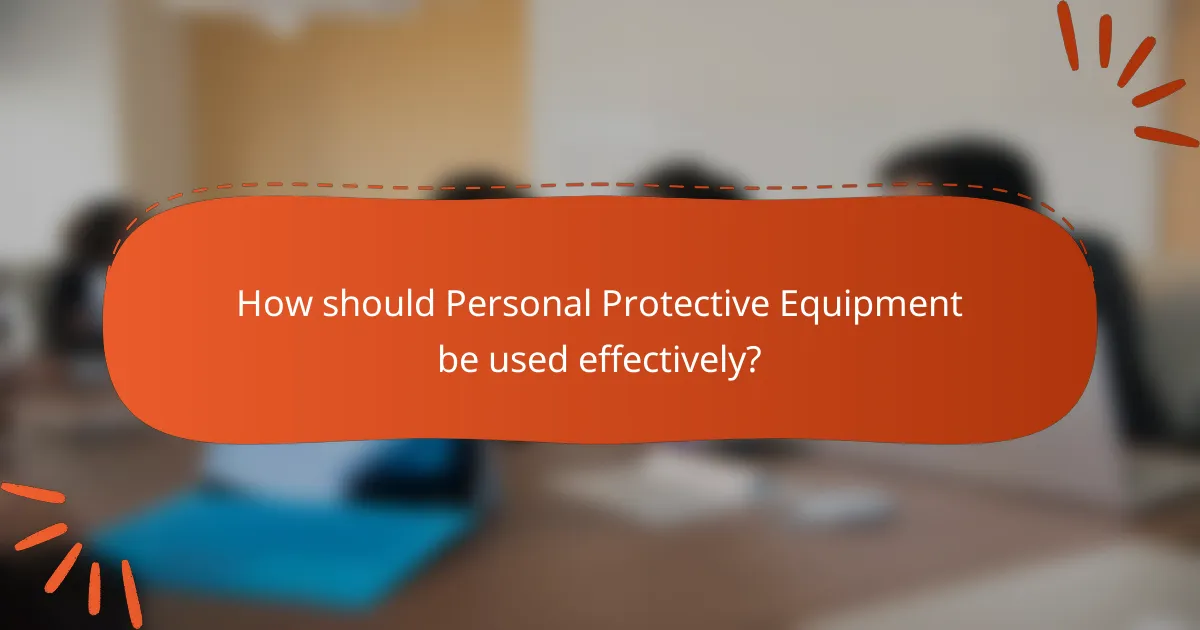
How should Personal Protective Equipment be used effectively?
Personal Protective Equipment (PPE) should be used effectively by ensuring proper selection, fit, and usage practices. Selecting appropriate PPE is crucial based on the specific hazards present in the workplace. For industrial adhesives, this may include gloves, goggles, and respirators. Each piece of equipment must fit properly to provide adequate protection. Users should inspect PPE before each use to ensure it is in good condition. Training on the correct usage of PPE enhances safety and compliance. Additionally, PPE should be removed and cleaned according to guidelines after exposure to hazardous materials. Regular maintenance prolongs the lifespan of the equipment and maintains its protective qualities.
What are the best practices for wearing Personal Protective Equipment?
The best practices for wearing Personal Protective Equipment (PPE) include proper selection, correct fit, and consistent usage. Selecting appropriate PPE ensures it matches the specific hazards present. The fit of PPE is crucial for comfort and effectiveness; ill-fitting equipment may not provide adequate protection. Users should always inspect PPE before use to identify any damage or wear. It is essential to wear PPE throughout the entire duration of exposure to hazards. Training on the correct usage of PPE enhances safety and compliance. Regular maintenance of PPE extends its lifespan and ensures reliability. Adhering to these practices minimizes risks associated with hazardous materials, including industrial adhesives.
How should Personal Protective Equipment be fitted for different users?
Personal Protective Equipment (PPE) should be fitted according to the individual user’s measurements and specific requirements. Accurate fitting ensures maximum protection and comfort. Each type of PPE, such as helmets, gloves, and respirators, has its own fitting guidelines. For example, helmets should sit snugly on the head without obstructing vision. Gloves must fit securely without being too tight or loose, allowing for dexterity. Respirators require a proper seal around the face to prevent inhalation of harmful substances.
Employers should conduct fit tests for respirators to ensure effectiveness. Regular checks and adjustments may be necessary as users’ body dimensions change. Training on proper fitting techniques can enhance safety. According to OSHA, improper fitting can lead to reduced protection and increased risk of injury or exposure.
What are the common mistakes to avoid when using Personal Protective Equipment?
Common mistakes to avoid when using Personal Protective Equipment (PPE) include improper fit, lack of training, and failure to inspect equipment. An improper fit can lead to reduced effectiveness and increased exposure to hazards. Lack of training can result in incorrect usage or neglecting to wear PPE altogether. Failing to inspect PPE before use may allow damaged or ineffective equipment to be worn, increasing risk. Additionally, using the wrong type of PPE for specific tasks can lead to inadequate protection. Regular maintenance and proper storage of PPE are also essential to ensure its longevity and effectiveness.
How can users ensure the longevity of their Personal Protective Equipment?
Users can ensure the longevity of their Personal Protective Equipment (PPE) by following proper care and maintenance practices. Regular cleaning of PPE is essential to remove contaminants and prevent degradation. Users should inspect PPE for any signs of wear or damage before each use. Proper storage in a cool, dry place protects PPE from environmental factors that can cause deterioration. Users should avoid exposing PPE to harsh chemicals that may compromise its integrity. Adhering to the manufacturer’s guidelines for use and maintenance extends the lifespan of PPE. Lastly, replacing PPE when it shows significant signs of wear is crucial for continued protection.
What maintenance practices are essential for Personal Protective Equipment used with industrial adhesives?
Regular inspection of Personal Protective Equipment (PPE) is essential for ensuring safety when using industrial adhesives. Inspect PPE for signs of wear, damage, or contamination before each use. Clean PPE according to manufacturer instructions to remove adhesive residues. Store PPE in a clean, dry environment to prevent degradation. Replace any damaged or worn PPE immediately to maintain effective protection. Ensure that all components, such as gloves and masks, are compatible with the specific adhesive being used. Training on proper usage and maintenance of PPE is crucial to ensure compliance and safety. Following these practices minimizes the risk of exposure to harmful substances in industrial adhesives.
How often should Personal Protective Equipment be inspected and replaced?
Personal Protective Equipment (PPE) should be inspected before each use and replaced as needed. Regular inspections are critical to ensure PPE is functioning correctly. Daily checks can identify visible damage, wear, or contamination. Additionally, PPE should be replaced according to the manufacturer’s recommendations. For example, respirators may need replacement after a specific number of uses or after exposure to hazardous materials. Industry standards often suggest a thorough inspection at least annually. This frequency helps maintain safety and compliance with regulations.
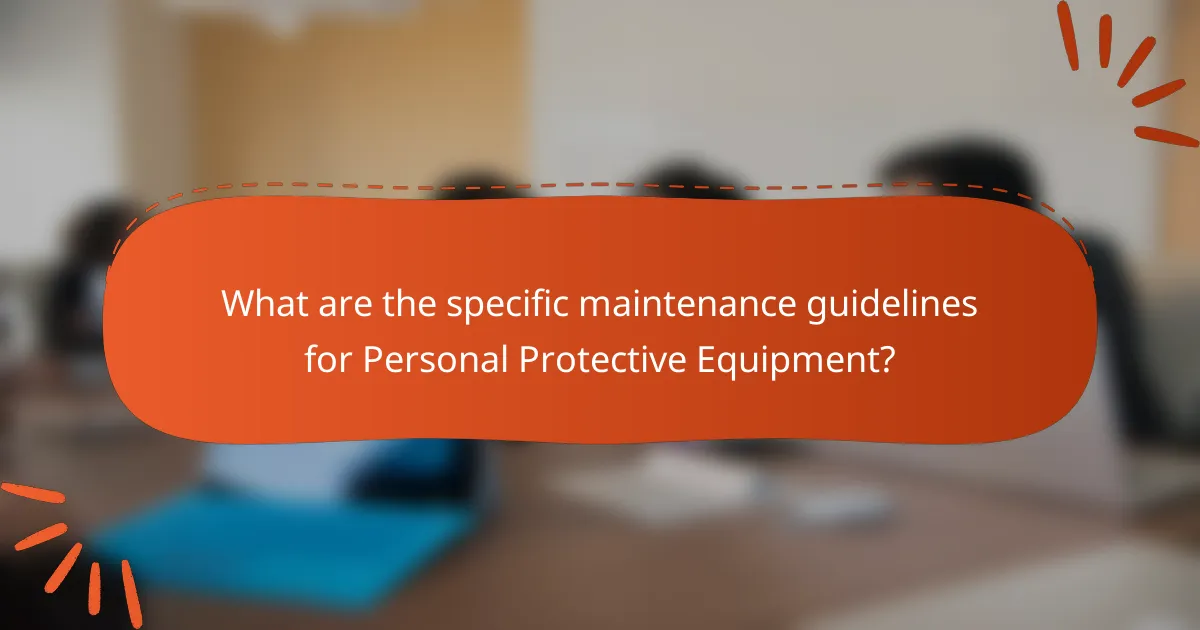
What are the specific maintenance guidelines for Personal Protective Equipment?
Personal Protective Equipment (PPE) requires specific maintenance guidelines to ensure effectiveness and safety. Regular inspections should be conducted to identify any damage or wear. Cleaning PPE according to manufacturer instructions is crucial to remove contaminants. Proper storage in a clean, dry environment prevents degradation. Replacement of damaged or expired PPE is necessary to maintain protection levels. Training users on the correct maintenance procedures enhances safety. Compliance with relevant safety standards, such as OSHA, supports proper maintenance practices. These guidelines are essential for ensuring that PPE functions as intended in hazardous environments.
How should Personal Protective Equipment be cleaned and stored?
Personal Protective Equipment (PPE) should be cleaned according to the manufacturer’s instructions. Cleaning methods may include washing with soap and water or using disinfectants. For reusable PPE, ensure it is thoroughly dried before storage. Store PPE in a clean, dry environment to prevent contamination. Avoid storing PPE in direct sunlight or damp areas. Regular inspections for wear and damage are essential. Proper maintenance extends the lifespan of PPE and ensures safety.
What cleaning agents are safe for different types of Personal Protective Equipment?
Cleaning agents safe for different types of Personal Protective Equipment (PPE) include mild soap solutions, isopropyl alcohol, and specific commercial disinfectants. Mild soap solutions effectively clean most PPE materials without causing damage. Isopropyl alcohol is safe for non-porous surfaces and helps disinfect without leaving residues. Commercial disinfectants should be chosen based on compatibility with the PPE material. For example, bleach solutions are suitable for certain fabrics but can degrade others. It’s essential to follow manufacturer guidelines for cleaning to ensure the longevity and effectiveness of PPE.
What storage conditions prolong the life of Personal Protective Equipment?
Personal Protective Equipment (PPE) lasts longer when stored in cool, dry environments. High temperatures can degrade materials used in PPE. Humidity can promote mold and mildew, which damage equipment. Direct sunlight can cause fading and brittleness in PPE materials. Storing PPE in protective cases or bags helps prevent physical damage. Regularly inspecting stored PPE ensures early detection of any deterioration. Following manufacturer guidelines for storage conditions is essential for optimal longevity.
What are the key takeaways for using Personal Protective Equipment with industrial adhesives?
Personal Protective Equipment (PPE) is essential when using industrial adhesives. PPE protects users from potential hazards such as chemical exposure and skin irritation. Common types of PPE include gloves, goggles, and respirators. Gloves prevent skin contact with adhesives, which can cause burns or allergic reactions. Goggles protect the eyes from splashes and fumes. Respirators safeguard against inhaling harmful vapors. Proper usage of PPE enhances safety and reduces health risks. Regular maintenance of PPE ensures effectiveness and longevity. Adhering to safety guidelines when using PPE is crucial for worker protection.
What tips can enhance safety while using industrial adhesives?
To enhance safety while using industrial adhesives, always wear appropriate personal protective equipment (PPE). This includes gloves, goggles, and respiratory protection as needed. Ensure proper ventilation in the workspace to minimize inhalation of fumes. Read and follow the safety data sheets (SDS) for specific adhesive products. Store adhesives in a cool, dry place away from direct sunlight. Avoid skin contact by using tools for application instead of hands. Dispose of any adhesive waste according to local regulations to prevent environmental hazards. Regularly inspect PPE for damage and replace as necessary to maintain effectiveness.
How can users stay updated on the latest Personal Protective Equipment recommendations?
Users can stay updated on the latest Personal Protective Equipment (PPE) recommendations by following industry-specific guidelines and resources. Government agencies like OSHA and CDC regularly publish updates on PPE standards and recommendations. Industry organizations also provide valuable information through newsletters and websites. Attending professional conferences and workshops can offer insights into current best practices. Subscribing to relevant journals ensures access to the latest research and developments. Engaging with online forums and professional networks can facilitate knowledge sharing among peers. Regularly checking manufacturers’ websites for product updates is also beneficial.
Personal Protective Equipment (PPE) for industrial adhesives is essential for safeguarding workers from hazardous substances commonly encountered in adhesive applications. This article covers various types of PPE, including gloves, goggles, respirators, and protective clothing, detailing their specific roles in preventing chemical exposure and injuries. It emphasizes the importance of proper usage, fitting, and maintenance practices to ensure the effectiveness of PPE in reducing health risks associated with industrial adhesives. Additionally, the article outlines best practices for cleaning, storing, and inspecting PPE to prolong its lifespan and maintain compliance with safety standards.
